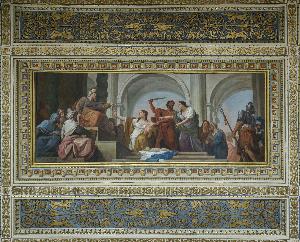Francesco Saverio Manno
Francesco Saverio Manno;Francesco Manno
Place: Palermo
Born: 1752
Death: 1831
Biography:
Francesco Saverio Manno was an Italian painter and architect born in Palermo, Italy in 1752. He originally worked as a goldsmith before devoting himself to painting. In 1786, he moved to Rome where he studied under Pompeo Batoni and Francesco Preziado de la Vega. He became the Secretary of the Accademia di San Luca and a member of the Accademia dei Virtuosi del Pantheon in 1794. Pope Pius VI favored him and appointed him Painter of the Sacred Apostolic Buildings in 1800.
Artistic Style and Notable Works
Manno was known for his Neoclassical style, which is evident in his major works such as Santi Apostoli, Palazzo Altieri, San Lorenzo in Lucina, Quirinal Palace, Santi Vincenzo e Anastasio a Trevi, and Palazzo Arcivescovile, Monreale. His paintings are characterized by their classical elements, harmonious proportions, and attention to detail.
Influence and Legacy
Manno's work had a significant influence on the development of Neoclassical art in Italy. He was also an accomplished architect, and his designs for buildings such as Palazzo Altieri and Quirinal Palace showcase his mastery of classical forms. Notable Collections featuring Manno's work include the Palumbo-Fossati Collection in Venice, Italy, which can be explored on Wikioo.org. The collection includes works by famous artists such as Thomas Moran, William James Glackens, and Gilbert Munger.
List of Notable Works
- Santi Apostoli
- Palazzo Altieri
- San Lorenzo in Lucina
- Quirinal Palace
- Santi Vincenzo e Anastasio a Trevi
- Palazzo Arcivescovile, Monreale
Manno's paintings can be found in various museums and collections, including the National Museum of Fine Arts in La Valletta, Malta. His work continues to inspire artists and art lovers alike, and his legacy as a Neoclassical painter and architect remains unparalleled. For more information on Francesco Saverio Manno and his works, visit Wikioo.org or explore the Wikipedia page dedicated to his life and art.


